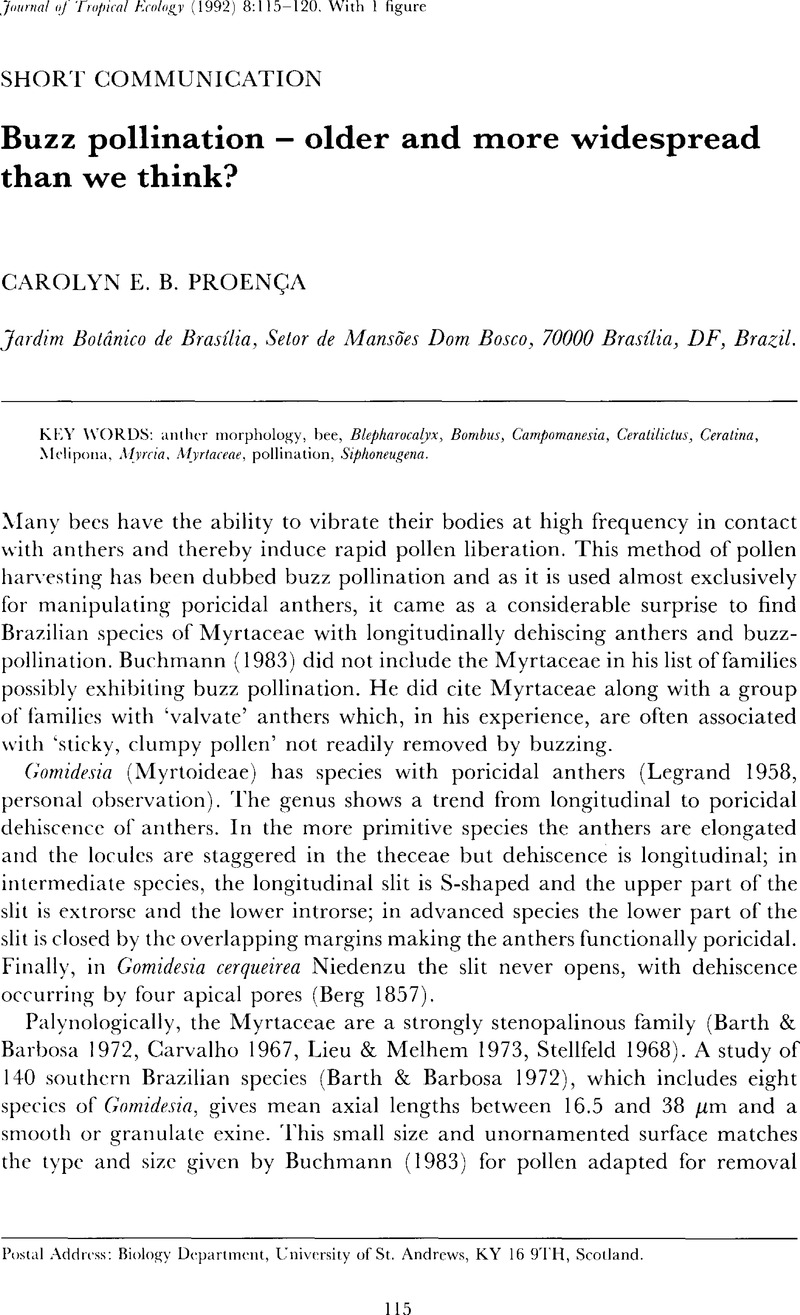Crossref Citations
This article has been cited by the following publications. This list is generated based on data provided by Crossref.
Schulz, Erhard
and
Lueke, Markus
1994.
A two year pollen calendar for traditionally produced honey types from Gaya, southern Niger.
Grana,
Vol. 33,
Issue. 4-5,
p.
254.
Granja E Barros, Mariliza A.
1996.
Biologia reprodutiva e polinização de espécies simpátricas de Diplusodon (Lythraceae).
Acta Botanica Mexicana,
p.
11.
Thorp, R. W.
2000.
The collection of pollen by bees.
Plant Systematics and Evolution,
Vol. 222,
Issue. 1-4,
p.
211.
Thorp, Robin W.
2000.
Pollen and Pollination.
p.
211.
Harter, Birgit
Leistikow, Carla
Wilms, Wolfgang
Truylio, Betânia
and
Engels, Wolf
2002.
Bees collecting pollen from flowers with poricidal anthers in a south BrazilianAraucariaforest: a community study.
Journal of Apicultural Research,
Vol. 41,
Issue. 1-2,
p.
9.
Silva, André Luiz Gomes da
and
Pinheiro, Maria Célia B.
2007.
Biologia floral e da polinização de quatro espécies de Eugenia L. (Myrtaceae).
Acta Botanica Brasilica,
Vol. 21,
Issue. 1,
p.
235.
Arceo‐Gómez, G.
Martínez, M. L.
Parra‐Tabla, V.
and
García‐Franco, J. G.
2011.
Anther and stigma morphology in mirror‐image flowers of Chamaecrista chamaecristoides (Fabaceae): implications for buzz pollination.
Plant Biology,
Vol. 13,
Issue. s1,
p.
19.
Michez, Denis
Vanderplanck, Maryse
and
Engel, Michael S.
2011.
Evolution of Plant-Pollinator Relationships.
p.
103.
Wanigasekara, R. W. M. U. M.
and
Karunaratne, W. A. I. P.
2012.
Efficiency of Buzzing Bees in Fruit Set and Seed Set ofSolanum violaceumin Sri Lanka.
Psyche: A Journal of Entomology,
Vol. 2012,
Issue. ,
p.
1.
dos Santos, Ana Paula Milla
Fracasso, Carla Magioni
Luciene dos Santos, Mirley
Romero, Rosana
Sazima, Marlies
and
Oliveira, Paulo Eugênio
2012.
Reproductive biology and species geographical distribution in the Melastomataceae: a survey based on New World taxa.
Annals of Botany,
Vol. 110,
Issue. 3,
p.
667.
De Luca, Paul A
and
Vallejo-Marín, Mario
2013.
What's the ‘buzz’ about? The ecology and evolutionary significance of buzz-pollination.
Current Opinion in Plant Biology,
Vol. 16,
Issue. 4,
p.
429.
Nunes-Silva, Patrícia
Hrncir, Michael
da Silva, Cláudia Inês
Roldão, Yara Sbrolin
and
Imperatriz-Fonseca, Vera Lucia
2013.
Stingless bees, Melipona fasciculata, as efficient pollinators of eggplant (Solanum melongena) in greenhouses.
Apidologie,
Vol. 44,
Issue. 5,
p.
537.
Ferreira, Marcos Gonçalves
and
Absy, Maria Lucia
2015.
Pollen niche and trophic interactions between colonies of Melipona (Michmelia) seminigra merrillae and Melipona (Melikerria) interrupta (Apidae: Meliponini) reared in floodplains in the Central Amazon.
Arthropod-Plant Interactions,
Vol. 9,
Issue. 3,
p.
263.
Staggemeier, Vanessa G.
Diniz-Filho, José Alexandre F.
Zipparro, Valesca B.
Gressler, Eliana
de Castro, Everaldo Rodrigo
Mazine, Fiorella
da Costa, Itayguara Ribeiro
Lucas, Eve
and
Morellato, Leonor Patrícia C.
2015.
Clade-specific responses regulate phenological patterns in Neotropical Myrtaceae.
Perspectives in Plant Ecology, Evolution and Systematics,
Vol. 17,
Issue. 6,
p.
476.
Bartoš, Michael
Tropek, Robert
Spitzer, Lukáš
Padyšáková, Eliška
Janšta, Petr
Straka, Jakub
Tkoč, Michal
and
Janeček, Štěpán
2015.
Specialization of pollination systems of two co-flowering phenotypically generalized Hypericum species (Hypericaceae) in Cameroon.
Arthropod-Plant Interactions,
Vol. 9,
Issue. 3,
p.
241.
Vasconcelos, Thais N. C.
Prenner, Gerhard
Bünger, Mariana O.
De-Carvalho, Plauto S.
Wingler, Astrid
and
Lucas, Eve J.
2015.
Systematic and evolutionary implications of stamen position in Myrteae (Myrtaceae).
Botanical Journal of the Linnean Society,
Vol. 179,
Issue. 3,
p.
388.
Berger, Brent A.
Kriebel, Ricardo
Spalink, Daniel
and
Sytsma, Kenneth J.
2016.
Divergence times, historical biogeography, and shifts in speciation rates of Myrtales.
Molecular Phylogenetics and Evolution,
Vol. 95,
Issue. ,
p.
116.
Moquet, Laura
Bruyère, Lydiane
Pirard, Benoit
and
Jacquemart, Anne‐Laure
2017.
Nectar foragers contribute to the pollination of buzz‐pollinated plant species.
American Journal of Botany,
Vol. 104,
Issue. 10,
p.
1451.
Ballare, Kimberly M.
Stevens, Lee
and
Jha, Shalene
2017.
Reproductive Biology of Three Wildflower Species: Implications of Floral Compatibility Systems and Pollen Limitation for Prairie Restoration.
Rhodora,
Vol. 119,
Issue. 979,
p.
212.
Cordeiro, G. D.
Pinheiro, M.
Dötterl, S.
Alves‐dos‐Santos, I.
and
Dafni, A.
2017.
Pollination of Campomanesia phaea (Myrtaceae) by night‐active bees: a new nocturnal pollination system mediated by floral scent.
Plant Biology,
Vol. 19,
Issue. 2,
p.
132.





